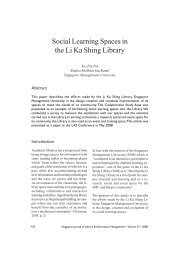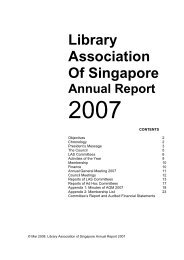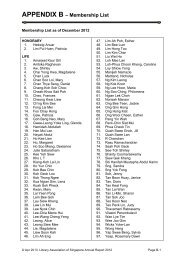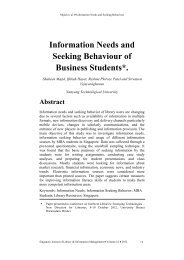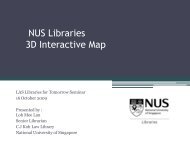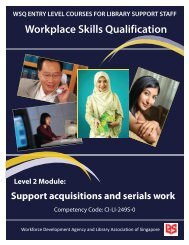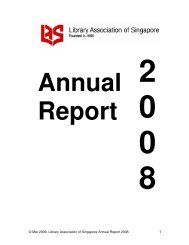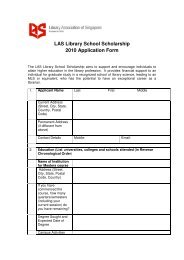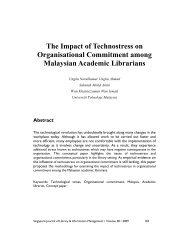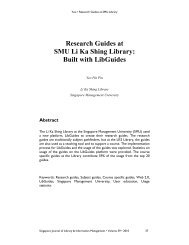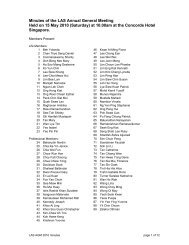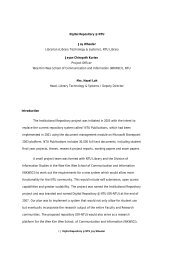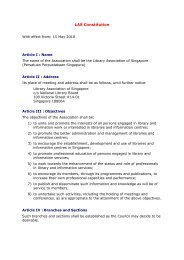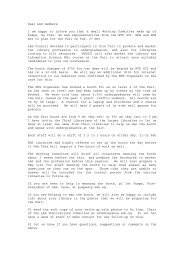English Schools and School - Library Association of Singapore
English Schools and School - Library Association of Singapore
English Schools and School - Library Association of Singapore
Create successful ePaper yourself
Turn your PDF publications into a flip-book with our unique Google optimized e-Paper software.
Lim • <strong>English</strong> <strong><strong>School</strong>s</strong> & <strong>School</strong> Libraries before WWII<br />
<strong>and</strong> the school came to be known as Victoria<br />
<strong>School</strong> (Old Victorians’ <strong>Association</strong><br />
1991).<br />
St Joseph’s Institution<br />
In 1927 the Senior Cambridge classes at<br />
St Joseph’s Institution were initiated. The<br />
school library consisted <strong>of</strong> three bookshelves<br />
occupying a room next to the Director’s<br />
<strong>of</strong>fice (Brown, 1987). During the<br />
late 1930s the school library <strong>and</strong> the science<br />
laboratory was sadly lacking (Tan<br />
1986). In 1940, the Director created a new<br />
school library (Brown, 1987; Balan, 1977)<br />
located along the west wing <strong>of</strong> the building<br />
(Tan, 1986). Mr Koh Cheng Yam, on<br />
Old Boy <strong>of</strong> the school, who worked for<br />
the architect firm <strong>of</strong> Swan & McLaren,<br />
supervised the work (Brown, 1987).<br />
St Patrick’s <strong>School</strong><br />
In 1932, St Patrick’s <strong>School</strong> was built to<br />
relieve the congestion at SJI (1977). The<br />
school was opened on 16 January 1933<br />
<strong>and</strong> Bro Stephen assumed its Directorship<br />
in 22 January 1934 (St Patrick’s <strong>School</strong>,<br />
1983). Frank James who taught <strong>English</strong><br />
literature, started the school library (Alfred,<br />
2002). On 5 June 1934, the new<br />
school library, “a rarity in <strong>Singapore</strong> at that<br />
time”, was opened by Bro Stephen (St<br />
Patrick’s <strong>School</strong> 1983, p. 20). In 1941, the<br />
school was turned into a military hospital<br />
after World War II broke in Europe (Alfred,<br />
2002).<br />
Anglo-Chinese <strong>School</strong><br />
In 1923, it was decided to build a new<br />
Anglo-Chinese <strong>School</strong> at Cairnhill <strong>and</strong> in<br />
1928 the building was opened as a secondary<br />
school (Dhoraisingam 1991). Subsequent<br />
to the early years no records<br />
which deal with reading or library was<br />
mentioned until the revived ACS maga-<br />
zine in 1929 referred to a Straits Times<br />
article that “ACS was setting a fine<br />
example…that her students by far outnumbered<br />
the students <strong>of</strong> any other school as<br />
members <strong>of</strong> the Raffles Junior <strong>Library</strong>”.<br />
This may, perhaps explain the apparent<br />
absence <strong>of</strong> a school library at Cairnhill:<br />
boys who wanted to read have a ready<br />
source near the school.<br />
However, small, specialized libraries were<br />
started during the 1930s for athletics, geography,<br />
history <strong>and</strong> photography. As an<br />
illustration, the history library began with<br />
37 volumes, growing to 62 in 1937, including<br />
works <strong>of</strong> both fiction <strong>and</strong> non-fiction.<br />
It was in the Principal’s report that the<br />
importance <strong>of</strong> reading was first made, “one<br />
<strong>of</strong> the aims <strong>of</strong> our school is the broadening<br />
<strong>of</strong> the mind an the cultivation <strong>of</strong> interests<br />
that are not purely <strong>of</strong> the textbook character…”.<br />
There was evidence that the<br />
class library was being pr<strong>of</strong>itably used: in<br />
st<strong>and</strong>ards 6 <strong>and</strong> 7, all boys except eight<br />
took out at least two books <strong>and</strong> the average<br />
taken was nine, indicating that a<br />
number <strong>of</strong> boys had developed a real taste<br />
<strong>of</strong> reading for pleasure, while considerable<br />
number augmented their reading by being<br />
members <strong>of</strong> the Raffles Junior <strong>Library</strong>.<br />
In 1938, in addition to the specialized libraries<br />
there were four class libraries.<br />
During the year, 159 new books were<br />
added, making a total <strong>of</strong> 950 volumes, as<br />
well as eight copies <strong>of</strong> the daily newspapers<br />
available on reading st<strong>and</strong>s that were<br />
always crowded before <strong>and</strong> after school,<br />
<strong>and</strong> during the interval. The most popular<br />
fiction authors among the seniors were<br />
Alex<strong>and</strong>er Dumas, Charles Dickens <strong>and</strong><br />
William Shakespeare. In the non-fiction<br />
category, biographies, religion <strong>and</strong> scientific<br />
writing were preferred by the seniors<br />
7 0 <strong>Singapore</strong> Journal <strong>of</strong> <strong>Library</strong> & Information Management • Volume 37 • 2008




